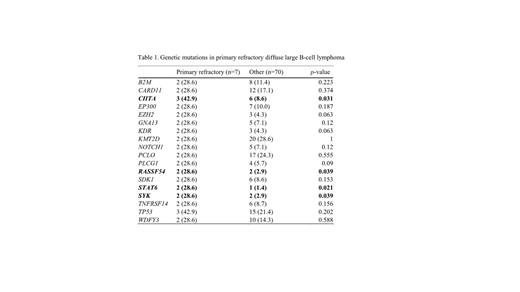Introduction
Diffuse large B-cell lymphoma (DLBCL) accounts for 30-40% of newly diagnosed adult non-Hodgkin lymphoma. About 60-70% of DLBCL patients could be cured with rituximab, cyclophosphamide, doxorubicin, vincristine and prednisolone (R-CHOP), while the other patients show chemo-refractory or relapse of disease and have poor prognosis. The prognostic difference between DLBCL patients is not fully understood, and many attempts to classify DLBCL have been made. Recently, with the development of the next generation sequencing (NGS) technique, Schmitz et al. identified four prominent genetic subtypes named MCD, BN2, N1, EZB. In this study, we performed targeted deep sequencing in DLBCL patients and analyzed whether there is any genetic difference between the patients who are primary refractory disease and the patients who are not.
Methods
Totally, 77 patients who was diagnosed with DLBCL and treated with R-CHOP from January 2021 to April 2023 were included in this analysis. Formalin-fixed, paraffin-embedded (FFPE) tumor samples obtained at diagnosis were archived. Genomic DNA was extracted using QIAmp DNA FFPE tissue kit according to the manufacturer's protocol. Genetic profiling included the targeted deep sequencing of 424 genes, which had been selected based on recurrent mutations from previous studies, and sequenced using an Illumina Nextseq. The threshold of mutation positivity as a variant allele frequency ≥2% for SNV/Indel and as a copy number ≥4.0(gain) for CNV. Patients were assigned as germinal center B-cell (GCB) or non-GCB subtype based on the immunohistochemistry (IHC) algorithm. BCL-2 and MYC FISH were conducted in patients with double-expressor DLBCL with non-GCB subtype.
Results
Median age of the patients were 66 years (24-86 years), and 49 patients (63.6%) were male. Forty-five patients (58.5%) were advanced stage. Twenty-four patients (31.2%) were GCB subtype and 51 patients (66.2%) were non-GCB subtype. Among the GCB type DLBCL patients, 10 patients were double expressor DLBCL, and there was no case of double hit lymphoma. As a result of targeted deep sequencing, 317 mutations were found in at least 1 patient, and the patients had a median number of 16 mutations (4-50). KMT2D was the most commonly detected mutation (22/77, 29.3%), followed by MYD88 (19/77, 25.3%), PCLO (19/77, 25.3%), PIM1 (19/77, 25.3%), TP53 (18/77, 24.0%). According to NGS analysis, 26 patients (33.85%) were assigned to MCD subgroup, 13 patients (16.9%) to BN2, 11 patients (14.3%) to N1, 10 patients (13.0%) to EZB, and 17 patients (17%) were not assigned to any subrgroup. Median follow-up of the patients was 13.8 months (0.4-22.8 months), and 12 patients (15.6%) relapsed and 5 patients (6.5%) died. Median PFS and OS were not reached. Among relapsed patients, 7 patients were primary refractory to R-CHOP. In primary refractory DLBCL patients, TP53 (3/7, 42.9%) and CIITA (3/7, 42.9%) were most commonly detected. CIITA is known to be associated with immune escape and treatment resistance. CIITA, RASSF54, STAT6, SYK significantly more mutated in the primary refractory patients than the other ( CIITA, 42.9% vs. 8.6%, p=0.031; RASSF54, 28.6% vs. 2.9%, p=0.039; STAT6, 28.6% vs. 1.4%, p=0.021; SYK, 28.6% vs. 2.9%, p=0.039) (Table 1).
Conclusion
CIITA, RASSF54, STAT6, SYK were frequently mutated in primary refractory DLBCL in this study. Because of the small sample size, however, the prognostic significance of these mutations needed to be studied in further researches.
Disclosures
No relevant conflicts of interest to declare.


This feature is available to Subscribers Only
Sign In or Create an Account Close Modal